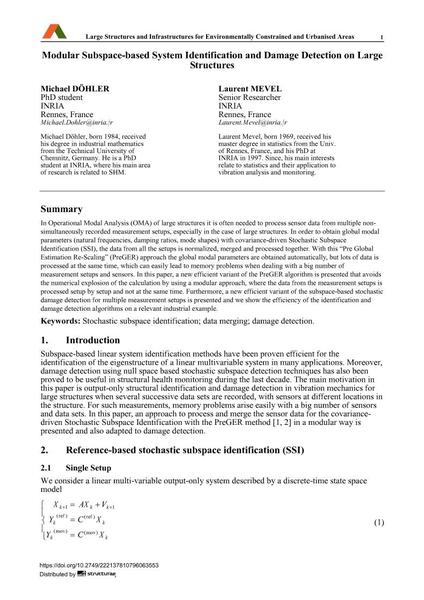Modular Subspace-based System Identification and Damage Detection on Large Structures

|
|
|||||||||||
Bibliografische Angaben
| Autor(en): |
Michael Döhler
Laurent Mevel |
||||
|---|---|---|---|---|---|
| Medium: | Tagungsbeitrag | ||||
| Sprache(n): | Englisch | ||||
| Tagung: | IABSE Symposium: Large Structures and Infrastructures for Environmentally Constrained and Urbanised Areas, Venice, Italy, 22-24 September 2010 | ||||
| Veröffentlicht in: | IABSE Symposium Venice 2010 | ||||
|
|||||
| Seite(n): | 736-737 | ||||
| Anzahl der Seiten (im PDF): | 8 | ||||
| Jahr: | 2010 | ||||
| DOI: | 10.2749/222137810796063553 | ||||
| Abstrakt: |
In Operational Modal Analysis (OMA) of large structures it is often needed to process sensor data from multiple non- simultaneously recorded measurement setups, especially in the case of large structures. In order to obtain global modal parameters (natural frequencies, damping ratios, mode shapes) with covariance-driven Stochastic Subspace Identification (SSI), the data from all the setups is normalized, merged and processed together. With this “Pre Global Estimation Re-Scaling” (PreGER) approach the global modal parameters are obtained automatically, but lots of data is processed at the same time, which can easily lead to memory problems when dealing with a big number of measurement setups and sensors. In this paper, a new efficient variant of the PreGER algorithm is presented that avoids the numerical explosion of the calculation by using a modular approach, where the data from the measurement setups is processed setup by setup and not at the same time. Furthermore, a new efficient variant of the subspace-based stochastic damage detection for multiple measurement setups is presented and we show the efficiency of the identification and damage detection algorithms on a relevant industrial example. |
||||
